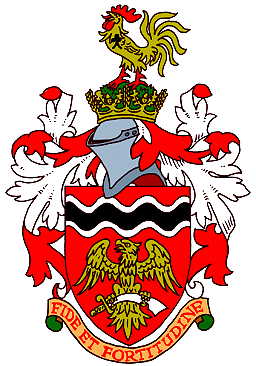Braintree RDC
| Heraldry of the World |
| British heraldry portal Civic heraldry of the United Kingdom |
|
BRAINTREE (Rural district council)
Incorporated into: 1974 Braintree
Official blazon
Arms : Gules an Eagle displayed wings inverted Or in the claws a Seax Argent hilt pommel and quillons Or in chief a Bar wavy Argent charged with another Sable.
Crest : Out of a Coronet composed of four Ears of Wheat and as many Acorns leaved set upon a Rim Or a Mount Vert thereon a Cock statant Gold combed wattled and legged Gules charged on the breast with a representation of the Device or Mark of Thomas Paycock of Great Coggeshal Sable.
Motto: 'FIDE ET FORTITUDINE' - By faith and courage
Origin/meaning
The arms were officially granted on December 20, 1962.
The district has many historical associations with the Romans, innumerable relics from that period have been discovered and two great Roman roads, namely Stane Street and Icknield Street, cross the district meeting at Marks Tey. The gold Roman eagle is therefore an apt charge, holding in its claws a seax upon a red background both from the County arms. The area is also traversed by the River Blackwater, which is alluded to by a typical heraldic pun, the black wavy bar at the top of the shield, edged with white for its tributaries.
The colours of the wreath are those of the County and of the Maxey family, who have connections with several parts of the district, and the rural coronet of wheatears and acorns represents agriculture, its ancillary industries and the natural amenities. In Great Coggeshall stands Paycocke's House, now preserved by the National Trust, it was built at the beginning of the sixteenth century by John Paycocke, as a wedding present for his son Thomas, a clothier. The Paycockes became prominent citizens of the town and contributed substantially to the fabric of the parish church. The merchant mark of the Paycockes, described variously as an ermine tail or a double-stalked clover leaf, is included in the decor of the house and is seen on the breast of the cock in the crest. The cock itself is taken from the seal of Coggeshall or (Coxhall) Abbey, founded by King Stephen and Queen Maud and granted the Manor of Coggeshall around 1140.
The motto is that of the Capels, Earls of Essex, another family prominent in the areas history.
Contact and Support
Partners:
Your logo here ?
Contact us
© since 1995, Heraldry of the World, Ralf Hartemink 
Index of the siteLiterature: Image and information from here












